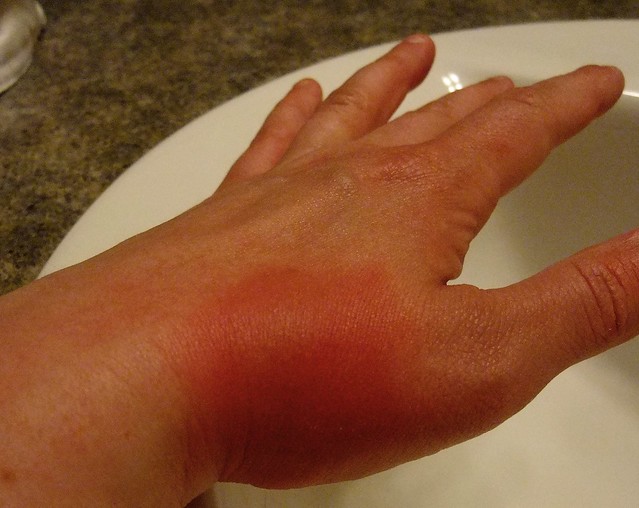Adverse Drug Reactions
 Ranging from mild, unnoticeable effects to severe anaphylactic shock, drugs have been known to cause untoward events in people who take them. Drugs may cause reactions directly or indirectly, at home, in the hospital, and particularly, during clinical trials. Adverse drug reactions are particularly important because developed countries are now in the era of polypharmacy (the population in such countries is often using on average at least 5 different medications at a time). The complexity of the drugs is increasing, the population is aging, and has limited capacity to metabolize (breakdown) ingested drugs. Examples of adverse drug events include hypotension after taking a double dose of anti-hypertensive drugs, hypoglycemia with anti-diabetics, and skin rashes caused by antibiotics.
Ranging from mild, unnoticeable effects to severe anaphylactic shock, drugs have been known to cause untoward events in people who take them. Drugs may cause reactions directly or indirectly, at home, in the hospital, and particularly, during clinical trials. Adverse drug reactions are particularly important because developed countries are now in the era of polypharmacy (the population in such countries is often using on average at least 5 different medications at a time). The complexity of the drugs is increasing, the population is aging, and has limited capacity to metabolize (breakdown) ingested drugs. Examples of adverse drug events include hypotension after taking a double dose of anti-hypertensive drugs, hypoglycemia with anti-diabetics, and skin rashes caused by antibiotics.
Kemi Francis Okwuegbuna, MD, MAS
Medical consultant, CRA-School Montreal
An Adverse Event (AE) is a harmful and unintended sign or symptom associated with the use of a drug, without making any judgment about causality to the drug. The event in question must be noticed soon after taking the drug and be different from the signs or symptoms seen before the drug was taken. In other words, there must be some evidence that the drug caused the reaction. If the causality relation is already established, it is called Adverse Drug Reaction (ADR).
Drugs may be taken in any form, from orally to intravenously; in any formulation- liquid, emulsion, or solid; and in different doses. The adverse reactions may be because of errors in administration, misuse, or abuse. Sometimes, the drug, if taken alone, may not cause an adverse event, but react with other substances such as food, drinks, or other drugs taken around the same time.
During clinical trials, unknown and unexpected ADRs may occur also if the study participants are taking any other drugs for other co-morbidities, as usually seen in elderly patients and in cancer studies, and a drug-to-drug interaction develops. The dose of the drug, time, or duration of exposure, genetic and physiological make-up of the patient also determine the extent of damage caused by the drug.
It is important to recognize the ADRs to document them based on their severity and seriousness. The information about them is collected and analyzed during the clinical trials, and after the drug is authorized for marketing during the whole life of the drug in the frame of the pharmacovigilance process. Serious adverse reactions must be immediately reported to the manufacturer.
Adverse reactions can range from mild to severe, and may have or not have serious consequences. If they lead to hospitalization, or permanent disability or death, they are called Serious Adverse Effects (SAE), Serious Adverse Reactions (SAR), or Serious Drug Reactions (SDR). For medical devices, they are called Serious Device Incidents (SDI). The definitions used are:
- Suspected ADR: There is a reasonable possibility that the event was caused by the drug.
- Expected ADR: The event is seen in the package insert of the drug or in the safety profile of drugs in a similar class.
- Unexpected ADR: any event which a patient experienced, but was not previously documented.
- Serious ADR: resulting in any of the following 5 outcomes:
-
-
-
- Death
- A life-threatening event, such as stroke, loss of consciousness.
- In-patient hospitalization or prolongation of hospitalization.
- Inability to perform activities of daily living, such as bathing, toileting, and feeding.
- Congenital anomaly or defect.
Important ADR may not be serious as previously defined but may require medical or surgical intervention.
Examples include drug abuse or convulsion (seizures), anaphylaxis, or toxic epidermal necrolysis.While many ADRs may be mild and not documented, some are a major cause of unscheduled hospital admissions and prolonged hospitalizations, which cost time and money, not forgetting the strained relationships amongst the health care providers, their patients, and caregivers.
It is thus imperative to prevent all avoidable ADRs by taking an adequate medical history, providing accurate information, and administering the drug as prescribed. Identification of susceptible persons based on age, gender, pregnancy status, and ethnicity with prompt modification of treatment choice and regular clinical and laboratory monitoring cannot be overstated. The prescriber should also study the product insert before prescribing for updated information.
What to do in the event of an ADR?
Some actions have proven useful to prevent or mitigate ADR, depending on the settings they were discovered and their severity:
-
-
- Stop the drug, or modify the dose until the event subsides, or tests and investigations are done.
- Do not induce vomiting if taken by mouth.
- Give antidotes if applicable.
- Transfer to appropriate medical centers depending on the severity of the reaction.
- Document the event to determine the nature and intervention.
-
Institutions and governments across the world should advocate for policies to establish a database to record and monitor all adverse drug reactions, identify the genetic variants in persons that may lead to ADRs, and build or update existing medical record systems. The information from these sources can easily be assessed by health care providers to save the lives of their patients.
Kemi Francis Okwuegbuna, MD
-
-


